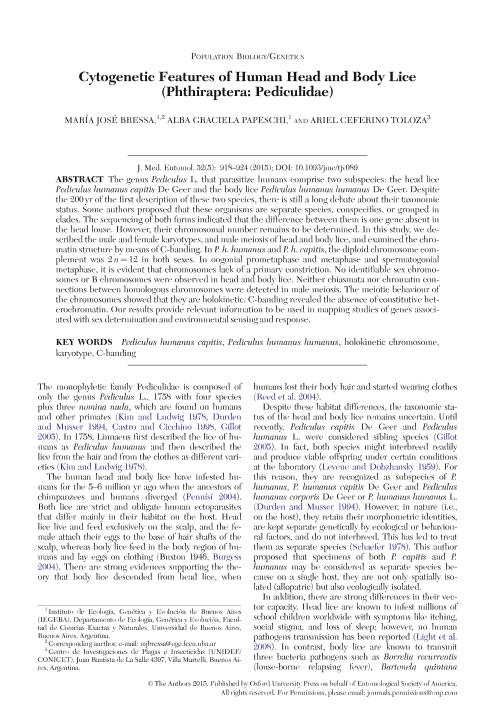Artículo
Cytogenetic Features of Human Head and Body Lice (Phthiraptera: Pediculidae)
Fecha de publicación:
09/2015
Editorial:
Entomological Society of America
Revista:
Journal of Medical Entomology
ISSN:
0022-2585
Idioma:
Inglés
Tipo de recurso:
Artículo publicado
Clasificación temática:
Resumen
The genus Pediculus L. that parasitize humans comprise two subspecies: the head lice Pediculus humanus capitis De Geer and the body lice Pediculus humanus humanus De Geer. Despite the 200 yr of the first description of these two species, there is still a long debate about their taxonomic status. Some authors proposed that these organisms are separate species, conspecifics, or grouped in clades. The sequencing of both forms indicated that the difference between them is one gene absent in the head louse. However, their chromosomal number remains to be determined. In this study, we described the male and female karyotypes, and male meiosis of head and body lice, and examined the chromatin structure by means of C-banding. In P. h. humanus and P. h. capitis, the diploid chromosome complement was 2n = 12 in both sexes. In oogonial prometaphase and metaphase and spermatogonial metaphase, it is evident that chromosomes lack of a primary constriction. No identifiable sex chromosomes or B chromosomes were observed in head and body lice. Neither chiasmata nor chromatin connections between homologous chromosomes were detected in male meiosis. The meiotic behaviour of the chromosomes showed that they are holokinetic. C-banding revealed the absence of constitutive heterochromatin. Our results provide relevant information to be used in mapping studies of genes associated with sex determination and environmental sensing and response.
Archivos asociados
Licencia
Identificadores
Colecciones
Articulos(UNIDEF)
Articulos de UNIDAD DE INVESTIGACION Y DESARROLLO ESTRATEGICOS PARA LA DEFENSA
Articulos de UNIDAD DE INVESTIGACION Y DESARROLLO ESTRATEGICOS PARA LA DEFENSA
Citación
Bressa, Maria Jose; Papeschi, Alba Graciela; Toloza, Ariel Ceferino; Cytogenetic Features of Human Head and Body Lice (Phthiraptera: Pediculidae); Entomological Society of America; Journal of Medical Entomology; 52; 5; 9-2015; 918-924
Compartir
Altmétricas




